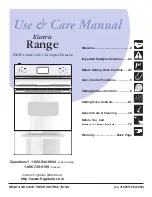
How it works
en
25
16.1 Product number (E-Nr.) and production
number (FD)
You can find the product number (E-Nr.) and the pro-
duction number (FD) on the appliance's rating plate.
You will see the rating plate with these numbers if you
open the appliance door.
Make a note of your appliance's details and the Cus-
tomer Service telephone number to find them again
quickly.
17 How it works
Here, you can find the ideal settings for various types
of food as well as the best accessories and cookware.
These recommendations are perfectly tailored to your
appliance.
17.1 Proceed as follows:
Note:
If you are using the appliance for the first time, follow
this important information:
¡
¡
¡
"Preventing material damage", Page 6
1.
Select a suitable type of food from the overview of
food.
Note:
If you do not find the exact food or application
that you want to prepare or implement, look for a
similar dish and take the general information into
consideration.
2.
Remove any accessories from the cooking compart-
ment.
3.
Select suitable cookware and accessories.
Use the cookware and the accessory listed in the
recommended settings.
4.
Only preheat the appliance if the recipe or the re-
commended settings tell you to do so.
5.
Use the recommended settings when configuring
the appliance settings.
6.
WARNING ‒ Risk of scalding!
Hot steam may escape when you open the appli-
ance door. Steam may not be visible, depending on
the temperature.
▶
Open the appliance door carefully.
▶
Keep children at a safe distance.
When the dish is ready, switch off the appliance.
17.2 Condensation
This section tells you how condensation is formed, how
you can prevent damage, and how you can prevent
condensation from forming.
When you are cooking food in the cooking compart-
ment, a lot of steam may form in the cooking compart-
ment. Since your appliance is extremely energy-effi-
cient, only a small amount of heat escapes during op-
eration. Due to the significant differences in temperat-
ure between the appliance interior and the external
parts of the appliance, condensation may build up on
the appliance door, the control panel or the front pan-
els of adjacent kitchen cabinets. The formation of con-
densation is a normal physical phenomenon.
In order to prevent damage, wipe away the condensa-
tion.
When you preheat the appliance, you reduce the build-
up of condensation.
17.3 Cooking tips
Observe this information when preparing food.
¡
The temperature and cooking time depend on the
amount of food and the recipe. Settings ranges are
specified for this reason. Select the lower value first.
¡
The setting values apply to food placed in the cook-
ing compartment while the cooking compartment is
still cold.
Do not place accessories into the cooking compart-
ment until it has finished preheating.
¡
Remove any accessories that are not being used
from the cooking compartment.
¡
Ensure that the accessory slides in the right way
round.
Reference gases
Unsuitable gas mixtures may impair the cooking power
level.
Note:
The appliance was manufactured in accordance
with the reference gases specified in the standards. If
you use gas that does not correspond to the specified
gas mixture and gas pressure, under certain circum-
stances, the power level and the heat output do not de-
liver the desired result.
Gas designation
Gas mixture in %
G20
CH
4
=100
G25
CH
4
=86, N
2
=14
G30
n-C
4
H
10
=50, i-C
4
H
10
=50
17.4 Initial baking
When baking, use the shelf positions indicated.
By burning the gas from the lower burner, heat is dis-
tributed in the oven. For this reason, the base of the
food is baked better.
















































